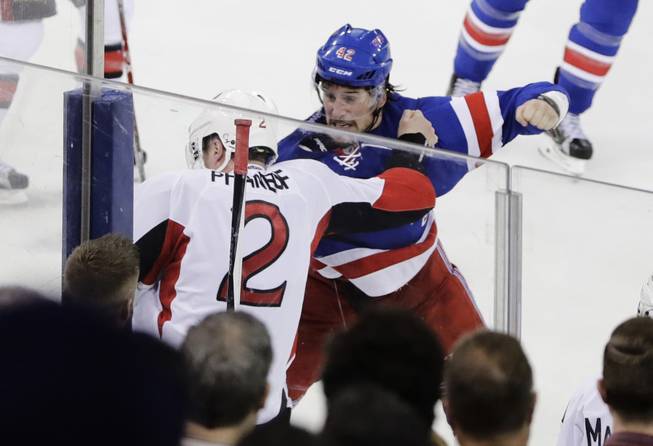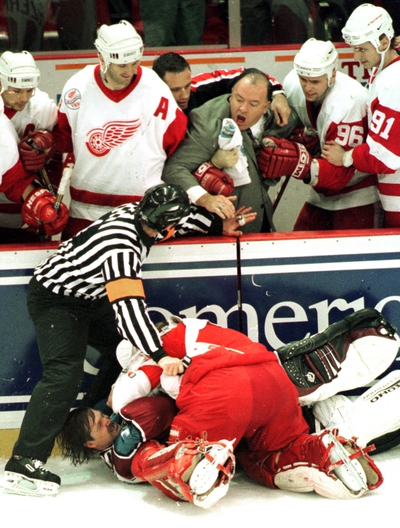
Frank Franklin II / Associated Press
Fans watch a fight between New York Rangers’ Brendan Smith and Ottawa Senators’ Dion Phaneuf during Game 4 of an NHL Stanley Cup second-round playoff series Thursday, May 4, 2017, in New York.
Saturday, May 13, 2017 | 2 a.m.
Related content
The hockey players’ gloves hit the ice. The men clutch the other’s jersey with one hand and bash their knuckles against one another’s faces with the other. The fans cheer in enjoyment.
The result is torn sweaters, black eyes, bloodied noses and a settled score.
The fight may have lasted only a few seconds, but it was initiated two shifts ago when one of the players slashed his stick across the wrist of the other.
“You head back to the bench and do what we call, ‘taking a number,’” said Murray Craven, the Vegas Golden Knights’ senior vice president who played in more than 1,000 NHL games.
The phrase, “taking a number,” conjures visions of dreaded trips to the Department of Motor Vehicles. While it does earn you a long, uncomfortable seat on the penalty box bench, what lands you there is slightly less boring and slightly more violent.
“There are definitely times you take that number down in the back of your mind, and if you get your chance then you will hopefully return the favor,” Craven said. “It all depends on the situation in the game and the situation in the year. If you are in the playoffs you better turn the other cheek.”
Fighting polices hockey to a level the referees can’t, because not every slash, elbow and dirty hit is seen or called.
In other major sports, fighting earns players lengthy suspensions and a major fines. Of the 15 longest suspensions in NBA history, nine of them are related to fighting. Meanwhile, almost all hockey fights are punishable by five minutes in the penalty box.
“In my opinion it still has a place in the game,” said Craven, who played in the 1980s and '90s when fighting was a much bigger part of the game. “We skate around at high speeds carrying weapons, and if you didn’t have checks and balances that stick-work could become much more detrimental to guys.”
Fighting in the NHL was at its high during the 1987-88 season, when there were 1,104 fights in 841 games for an average of 1.3 per game, according to dropyourgloves.com. That number has dropped off dramatically — this season there were only 424 fights in 1,230 games (0.34 per game).
Fights aren’t always between the two players involved in the play. Teams often protect their star players with bigger, stronger players that seek redemption for a cheap shot on the team’s breadwinner.
“You can’t have guys whacking the star players to a point where they are almost injuring them,” Craven said. “The fans don’t pay to watch the fourth-line guys. They want to see Connor McDavid, Sidney Crosby and Alex Ovechkin.”
Craven wasn’t a big brawler, but said he was involved in about two fights per year during his career.
“If you didn’t have that threat of someone coming out and basically beating the crap out of you, then you can take liberties with those star players,” Craven said. “Wayne Gretzky had Marty McSorley sitting on the bench and you knew if you did something to Gretzky, McSorley was coming for you.”
One of the more known scenes in hockey history happened when goaltenders Patrick Roy and Chris Osgood skated 100 feet to meet at center ice and duke it out, ending with Roy’s face streaming with blood.
As barbarous as fighting is, there are a surprising number of rules, regulations and etiquette to it. Here are some:
• Players must drop their gloves and cannot purposely remove their helmet.
• Fights are only allowed under mutual consent of both players.
• Only two players are allowed in a fight, but multiple fights may take place at once.
• A referee can break up a fight whenever they feel necessary (usually if one player falls to the ice).
• Players respect somewhat of a “code” that they stop fighting if one player has clearly lost or hurt.
• Referees will deem one player an aggressor if he, “continues to throw punches in an attempt to inflict punishment on his opponent who is in a defenseless position or who is an unwilling combatant.” In that case, the player is thrown out of the game and usually suspended.
• Fights must occur during play, which explains why some fights occur the second the referee drops the puck to start play.
Jesse Granger can be reached at 702-259-8814 or [email protected]. Follow Jesse on Twitter at twitter.com/JesseGranger_.


Join the Discussion:
Check this out for a full explanation of our conversion to the LiveFyre commenting system and instructions on how to sign up for an account.
Full comments policy